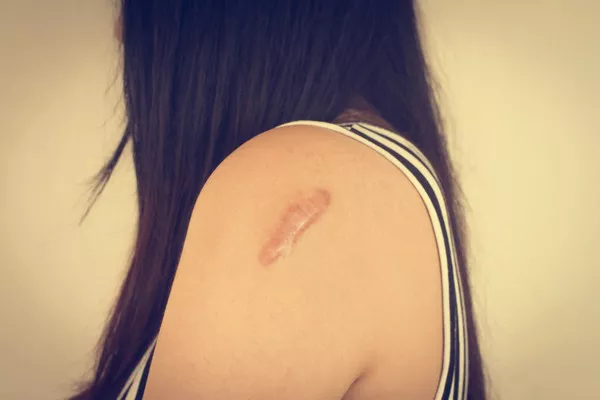Keloids are a type of raised scar that occurs when the body overproduces collagen in response to skin trauma, such as acne, surgery, or injury. These scars can be not only physically disfiguring but also emotionally distressing for those who have them. While there are various treatment options available, including surgical removal, steroid injections, and laser therapy, many individuals seek alternative remedies, such as vitamin E, to help manage their keloids. In this article, we’ll explore the potential benefits of vitamin E for keloids and examine the evidence supporting its use as a treatment option.
Understanding Keloids: Causes and Characteristics
Before delving into the role of vitamin E in keloid treatment, it’s essential to understand what keloids are and how they form. Keloids are characterized by their raised, shiny appearance and often extend beyond the boundaries of the original wound. They can be red, pink, or purple in color and may cause itching, pain, or tenderness.
Keloids form when the body’s natural healing process goes awry. After skin trauma, such as a cut or burn, the body produces excess collagen, resulting in the formation of a raised scar. While the exact cause of keloids is not fully understood, factors such as genetics, skin type, and hormonal changes may contribute to their development.
Treatment Options for Keloids
There are several treatment options available for keloids, ranging from topical therapies to surgical interventions. Some of the most common treatments include:
Steroid Injections: Corticosteroid injections can help reduce inflammation and flatten keloids by inhibiting collagen production.
Surgical Removal: Surgical excision involves cutting out the keloid and closing the wound with stitches. However, keloids have a high tendency to recur after surgery.
Laser Therapy: Laser treatments can help reduce the size and appearance of keloids by targeting blood vessels and collagen.
Silicone Gel or Sheets: Silicone-based products can help flatten and soften keloids by hydrating the skin and reducing inflammation.
While these treatments can be effective for some individuals, they may not always provide satisfactory results. As a result, many people explore alternative remedies, such as vitamin E, in hopes of finding relief from their keloids.
The Role of Vitamin E in Keloid Treatment
Vitamin E, also known as tocopherol, is a fat-soluble antioxidant that is essential for maintaining healthy skin. It is believed to have anti-inflammatory and wound-healing properties, making it a popular choice for treating scars, including keloids.
Proponents of vitamin E for keloid treatment suggest that applying vitamin E oil or cream to the affected area can help soften the scar tissue, reduce inflammation, and improve the appearance of keloids over time. Additionally, some individuals may choose to take vitamin E supplements orally to promote skin health from within.
Examining the Evidence: Does Vitamin E Help Keloids?
While anecdotal reports and testimonials abound regarding the effectiveness of vitamin E for keloids, scientific evidence supporting its use is limited and conflicting. Several studies have investigated the efficacy of vitamin E in treating scars, including keloids, but the results have been mixed.
A systematic review published in the Journal of Plastic, Reconstructive & Aesthetic Surgery in 2016 analyzed the results of seven clinical trials examining the use of vitamin E for scar management. The review found no significant difference in scar appearance between individuals treated with vitamin E and those treated with a placebo or alternative therapy. Additionally, some participants experienced adverse reactions to vitamin E, such as contact dermatitis or allergic reactions.
Another study published in the Dermatologic Surgery journal in 2010 compared the effectiveness of onion extract gel, silicone gel, and vitamin E oil in treating surgical scars. The study found that while onion extract and silicone gel were effective in improving scar appearance, vitamin E had no significant impact on scar healing and may even worsen scar appearance in some cases.
These findings suggest that while vitamin E may offer some benefits for certain individuals, it is not universally effective for treating keloids and may not be suitable for everyone. Additionally, there is a risk of adverse reactions associated with vitamin E use, highlighting the importance of caution and consultation with a healthcare professional before initiating treatment.
Considerations and Precautions
Before using vitamin E for keloid treatment, it’s essential to consider the following precautions:
Consultation with a Healthcare Professional: Before starting any new treatment regimen, including the use of vitamin E, it’s important to consult with a dermatologist or healthcare provider. They can assess the severity of your keloids and recommend the most appropriate treatment options based on your individual needs and medical history.
Patch Test: Before applying vitamin E oil or cream to a large area of skin, it’s advisable to perform a patch test to check for allergic reactions or sensitivity. Apply a small amount of vitamin E to a small, discreet area of skin and monitor for any adverse reactions, such as redness, itching, or irritation.
Use as Directed: If using vitamin E oil or cream topically, follow the manufacturer’s instructions for application. Avoid applying excessive amounts of vitamin E to the skin, as this may increase the risk of adverse reactions or interfere with wound healing.
Monitor for Adverse Reactions: While vitamin E is generally considered safe for topical use, some individuals may experience allergic reactions or skin irritation. If you experience any adverse reactions while using vitamin E, discontinue use immediately and consult with a healthcare professional.
Be Patient: It’s important to remember that keloid treatment takes time, and results may not be immediate. Be patient and consistent with your chosen treatment regimen, and monitor your progress over time. If you’re not seeing improvement or if your keloids are worsening, consult with a healthcare professional for further evaluation and guidance.
Conclusion
Keloids can be a source of physical discomfort and emotional distress for those who have them, prompting many individuals to explore alternative treatment options, such as vitamin E. While vitamin E is believed to have potential benefits for scar management, including keloids, scientific evidence supporting its use is limited and conflicting.
Before using vitamin E for keloid treatment, it’s essential to consult with a healthcare professional to determine the most appropriate course of action based on your individual needs and medical history. Additionally, it’s important to use vitamin E as directed and monitor for any adverse reactions or changes in your keloids over time.
While vitamin E may offer some benefits for certain individuals, it is not a guaranteed solution for keloids, and results may vary from person to person. If you’re struggling with keloids or other types of scars, don’t hesitate to reach out to a dermatologist or healthcare provider for guidance and support. With proper treatment and care, you can take steps toward managing your keloids and improving your overall skin health and well-being.
[inline_related_posts title=”You Might Be Interested In” title_align=”left” style=”list” number=”6″ align=”none” ids=”6946,6943,6940″ by=”categories” orderby=”rand” order=”DESC” hide_thumb=”no” thumb_right=”no” views=”no” date=”yes” grid_columns=”2″ post_type=”” tax=””]
































